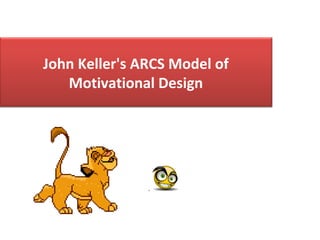
John keller's arcs model of motivational design - PPT
- 1. John Keller's ARCS Model of Motivational Design
- 2. Introduction • Motivating the learner to engage with the learning is a critical part of the learning process. There are a number of descriptive and prescriptive models that examine how the instructional design can be used to provide this motivation. • The ARCS Model of Motivational Design is one of the best-known prescriptive models. It was developed by John M. Keller of Florida State University (Keller, 1983,1987) in the context of classroom instruction. According to John Keller (1988), there are four steps in the instructional design process — Attention, Relevance, Confidence, & Satisfaction (ARCS).
- 4. Attention • Attention can be gained in two ways: • Perceptual arousal - uses surprise or uncertainly to gain interest. Uses novel, surprising, incongruous, and uncertain events.
- 5. • Inquiry arousal - stimulates curiosity by posing challenging questions or problems to be solved. Stimulates information seeking behavior by posing or having the learner generate questions or a problem to solve. Maintain interest by varying the elements of instruction.
- 6. Methods for grabbing the learners' attention include: • Specific examples - Use a visual stimuli, story, or biography. • Active Participation or Hands-on - Involve the learners with role playing, games, lab work, or other simulations that allows them to get them involved with the material or subject matter.
- 7. • Incongruity and Conflict - Pose facts or statements that run contrary to the learner's previous experiences. Play devils advocate while discussing the subject to be covered. • Inquiry - Stimulate curiosity by posing questions or problems for the learners to solve. It may include such activities as brainstorming or performing team research.
- 8. • Humor - Break up monotony and maintain interest by lightening the subject. However, too much humor distracts from your main topic. The goal is to hold your learner's attention, not to become a stand up comedian.
- 9. • Variability - Combine a variety of methods in presenting material. For example, a 15 lecture, watch a video, then divide the classroom into groups to review the material and to answer questions posed by it. Using a variety of methods reinforces the material and helps to incorporate a variety of learning styles.
- 10. • The first step, gaining the learner's attention, is normally relatively easy; the key is to then maintain their attention at an optimal level after grabbing them. You have to keep them from becoming bored nor over stimulate them (arousal).
- 11. Relevance Emphasize relevance within the instruction to increase motivation by using concrete language and examples with which the learners are familiar. They are six major strategies For accomplishing this: • Experience - Tell the learners how the new learning will use their existing skills. We best learn by building upon our preset knowledge or skills.
- 12. • Present Worth - What will the subject matter do for me today? • Future Usefulness - What will the subject matter do for me tomorrow?
- 13. • Needs Matching - Take advantage of the dynamics of achievement, risk taking, power, and affiliation (see Maslow's Hierarchy of Needs). • Modeling - First of all, "be what you want them to do!" Other strategies include guest speakers, videos, and having the learners who finish their work first to serve as tutors. • Choice - Allow the learners to use different methods to pursue their work or allowing s choice in how they organize it.
- 14. Confidence Allow the learners to succeed! However, present a degree of challenge that provides meaningful success: • Provide Objectives and Prerequisites - Help students estimate the probability of success by presenting performance requirements and evaluation criteria. Ensure the learners are aware of performance requirements and evaluative criteria.
- 15. • Grow the Learners - Every learning journey begins with a single step that builds upon itself. This allows a number of small success that gets more challenging with every step. Learners should understand that there is a correlation between the amount of energy they put into a learning experience and the amount of skill and knowledge they will gain from that experience.
- 16. • Feedback - Provide feedback and support internal attributions for success. • Learner Control - Learners should feel some degree of control over their learning and assessment .They should believe that their success is a direct result of the amount of effort they have put forth.
- 17. Satisfaction Satisfaction is based upon motivation, which can be intrinsic or extrinsic. • Provide opportunities to use newly acquired knowledge or skill in a real or simulated setting. Provide feedback and reinforcements that will sustain the desired behavior. If learners feel good about learning results, they will be motivated to learn. Some basic rules are: • Do not annoy the learner by over-rewarding simple behavior.
- 18. • If negative consequences are too entertaining the learners may deliberately choose the wrong answer. • Using too many extrinsic rewards may eclipse the instruction. • Notice that satisfaction is closely related to confidence. If you allow the learners to build confidence, satisfaction will follow if the task remains challenging.
- 19. Conclusion • B.F. Skinner had a major influence on ID through behaviorism and programmed instruction. He believed the best way for creating a good learning environment was to identify the desired behavior, then create situations in which successive approximations of the behavior would occur and be reinforced.